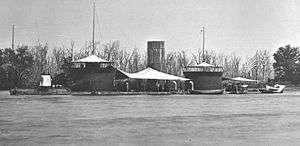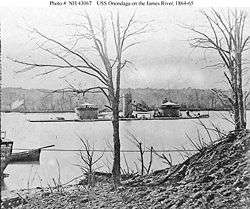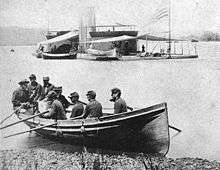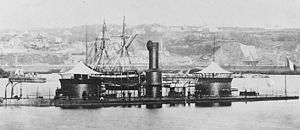USS Onondaga (1863)
 Onondaga at anchor on the James River, Virginia, circa 1864-65 | |
| History | |
|---|---|
| Name: | USS Onondaga |
| Namesake: | A lake and county in New York |
| Ordered: | 26 May 1862 |
| Builder: | Continental Iron Works, Greenpoint, Brooklyn |
| Laid down: | 1862 |
| Launched: | 29 July 1863 |
| Sponsored by: | Sally Sedgwick |
| Commissioned: | 24 March 1864 |
| Decommissioned: | 8 June 1865 |
| Fate: | Sold 7 March 1867 to her builder, G. W. Quintard, and subsequently resold to France |
| Name: | Onondaga |
| Acquired: | 7 March 1867 |
| Commissioned: | 15 June 1869 |
| Struck: | 2 December 1904 |
| Fate: | Sold for scrap, 1904 |
| General characteristics | |
| Type: | Double-turreted river monitor |
| Tonnage: | 1,250 tons (bm) |
| Displacement: | 2,592 long tons (2,634 t) |
| Length: | 226 ft (68.9 m) (o/a) |
| Beam: | 51 ft 5 in (15.7 m) |
| Draft: | 12 ft 10 in (3.9 m) |
| Installed power: | |
| Propulsion: | |
| Speed: | 7 knots (13 km/h; 8.1 mph) |
| Complement: | 130 officers and enlisted men |
| Armament: |
|
| Armor: |
|
USS Onondaga was a river monitor built for the Union Navy during the American Civil War. The ship spent her entire active career with the James River Flotilla, covering the water approaches to Richmond, Virginia, during the last year of the Civil War. After the war, she was purchased by France.
American Service
Constructed in New York
Onondaga – the first U.S. Navy ship to bear the name – was a double-turreted monitor launched 29 July 1863. She was built at the Continental Iron Works, Greenpoint, Brooklyn, under subcontract from George W. Quintard who built her engines at his neighboring Morgan Iron Works. She was sponsored by Sally Sedgwick, daughter of former U.S. Representative Charles B. Sedgwick and commissioned at New York Navy Yard on 24 March 1864, with Captain Melancthon Smith in command.
Assigned to the James River flotilla

With USS Mattabesett, the ship departed New York, New York, 21 April 1864, and arrived at Hampton Roads two days later. Assigned to the James River Flotilla, Onondaga supported General Ulysses S. Grant's drive on Richmond, Virginia. On 24 November, together with the monitor USS Mahopac, she engaged Confederate artillery batteries on the James River at Howlett’s Farm, Virginia, and resumed the attack 5 and 6 December.
Early in January 1865, most of the Union ironclads were withdrawn from the James River as Rear Admiral David D. Porter assembled a powerful fleet for the forthcoming attack on Fort Fisher, North Carolina. Onondaga was the only monitor left to guard Union forces along the James against Flag Officer John K. Mitchell’s Confederate James River Squadron.

When the Southern squadron steamed down river to attack the weakened Union forces, Onondaga dropped downstream to a position where she could maneuver more easily. She and her supporting gunboats awaited them only to have the attack blunted when Mitchell’s ironclads Virginia II and Richmond, gunboat Drewry, and torpedo boat Scorpion all ran aground trying to pass obstructions at Trent's Reach. After attacks by Northern shore batteries and Onondaga, Drewry exploded, Scorpion was abandoned, and the two Southern ironclads withdrew upriver when they were refloated the next day.
The decision to move Onondaga downstream resulted in her Commanding Officer, Commander William Albert Parker, being arrested and tried by court-martial for "neglect of duty in not offering battle to the Confederate ironclads" during this encounter. The court martial findings, identifying Parker as guilty, were reviewed and set aside by Secretary Welles.[1]
Final war operations
Onondaga continued to support Union troops for the rest of the war, steamed north after its end and was decommissioned at New York City on 8 June 1865. She was laid up at League Island, Pennsylvania. By Act of Congress approved 7 March 1867, the monitor was sold to her builder, G. W. Quintard and subsequently resold to France.
French Service

Onondaga retained her name and was rearmed in French service, receiving 9.4-inch rifled guns in place of her U.S. battery of 8-inch Parrott rifles and 15-inch Dahlgren smoothbores. She was sold for scrap in 1904.
Notes
- ↑ "Recent Deaths: Capt. Wm. A. Parker". Army and Navy Journal. 20: 287. October 28, 1883.
References
- This article incorporates text from the public domain Dictionary of American Naval Fighting Ships. The entry can be found here.
- de Balincourt, Captain; Vincent-Bréchignac, Captain (1977). "The French Navy of Yesterday: Coast Defense Ships". F.P.D.S. Newsletter. Akron, OH: F.P.D.S. V (3): 21.
- Canney, Donald L. (1993). The Old Steam Navy: The Ironclads, 1842–1885. 2. Annapolis, Maryland: Naval Institute Press. ISBN 0-87021-586-8.
- Gibbons, Tony (1989). Warships and Naval Battles of the Civil War. New York: Gallery Books. ISBN 0-8317-9301-5.
- Olmstead, Edwin; Stark, Wayne E.; Tucker, Spencer C. (1997). The Big Guns: Civil War Siege, Seacoast, and Naval Cannon. Alexandria Bay, New York: Museum Restoration Service. ISBN 0-88855-012-X.
- Silverstone, Paul H. (2006). Civil War Navies 1855-1883. The U.S. Navy Warship Series. New York: Routledge. ISBN 0-415-97870-X.